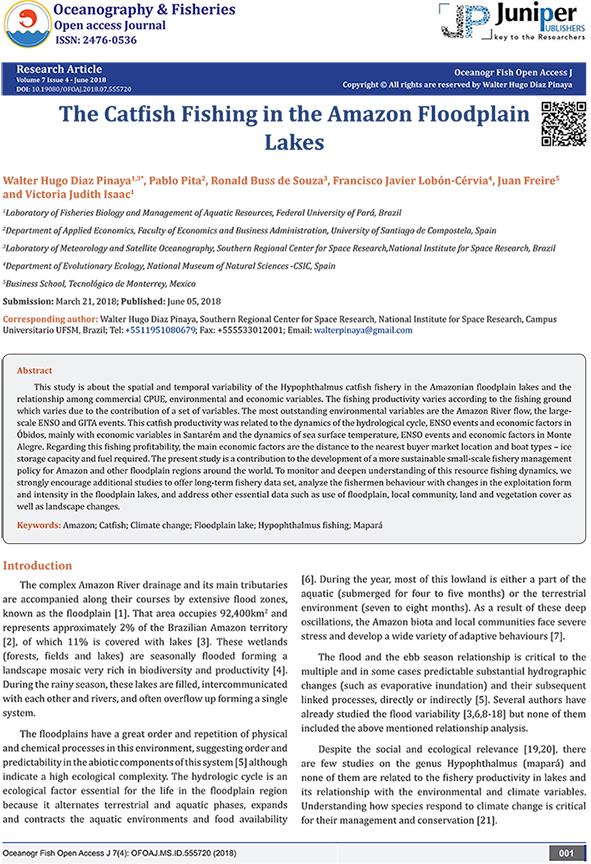Este es el nuevo trabajo, liderado por Walter Pinaya, que acabamos de publicar en la revista Oceanography & Fisheries Open Access Journal sobre la pesca del pez gato Hypophthalmus spp en la llanura de inundación del Amazonas. El acceso al artículo es libre y gratuito:
Archivo de la etiqueta: research
La pesca marítima recreativa en Europa
Acaba de publicarse nuestro artículo sobre la pesca marítima recreativa en Europa. La revista es Fish and Fisheries y es de acceso gratuito:
Recreational sea fishing in Europe in a global context—Participation rates, fishing effort, expenditure, and implications for monitoring and assessment
Abstract
Marine recreational fishing (MRF) is a high-participation activity with large economic value and social benefits globally, and it impacts on some fish stocks. Although reporting MRF catches is a European Union legislative requirement, estimates are only available for some countries. Here, data on numbers of fishers, participation rates, days fished, expenditures, and catches of two widely targeted species were synthesized to provide European estimates of MRF and placed in the global context. Uncertainty assessment was not possible due to incomplete knowledge of error distributions; instead, a semi-quantitative bias assessment was made. There were an estimated 8.7 million European recreational sea fishers corresponding to a participation rate of 1.6%. An estimated 77.6 million days were fished, and expenditure was €5.9 billion annually. There were higher participation, numbers of fishers, days fished and expenditure in the Atlantic than the Mediterranean, but the Mediterranean estimates were generally less robust. Comparisons with other regions showed that European MRF participation rates and expenditure were in the mid-range, with higher participation in Oceania and the United States, higher expenditure in the United States, and lower participation and expenditure in South America and Africa. For both northern European sea bass (Dicentrarchus labrax, Moronidae) and western Baltic cod (Gadus morhua, Gadidae) stocks, MRF represented 27% of the total removals. This study highlights the importance of MRF and the need for bespoke, regular and statistically sound data collection to underpin European fisheries management. Solutions are proposed for future MRF data collection in Europe and other regions to support sustainable fisheries management.
Combinando el conocimiento de los pescadores y herramientas de gestión baratas en la gestión de pesquerías recreativas marinas: el caso de estudio de las pesquerías de calamar y sepia en la Ría de Vigo
Se acaba de publicar en la revista Fisheries Management and Ecology nuestro artículo sobre el uso del conocimiento de los pescadores y de herramientas de gestión baratas, aplicado a la pesquería recreativa de calamares y sepias en la Ría de Vigo Este artículo forma parte de los resultados del Proyecto RECREGES. El título original:
Combining fishers’ knowledge and cost-effective monitoring tools in the management of marine recreational fisheries: A case study of the squid and cuttlefish fishery of the Ría of Vigo (NW Spain).
Abstract
A new methodology based in the use of fishers’ knowledge and cost-effective tools to obtain information about marine recreational fisheries (MRF) is presented. The squid and cuttlefish fishery of the Ría of Vigo (NW Spain) was selected because it is managed in a data-poor environment. In-depth interviews (57) were conducted with fishers, collecting ecological and socio-economic information. A cartography of fishing grounds based on their knowledge was obtained, while the intensity of effort and catches was mapped by the monitoring of two vessels with low-cost GPS data loggers. The 102 shore anglers and 248 recreational boats catch 8 t/year of European squid Loligo vulgaris and 11 t/year of common cuttlefish Sepia officinalis (11% of total catches on these species in the area). Shore anglers fish from 11 ports, while boat fishers use 14 fishing grounds (covering 30 km2). Most of the catches (86%) are landed by boats, and their CPUE is higher in the outer part of the Ría of Vigo. The use of fishers’ knowledge and cost-effective monitoring is encouraged to obtain information for the management of MRF. Given the economic contribution of MRF (260,000 €/year in direct expenses), this activity should be considered in the regulations.

